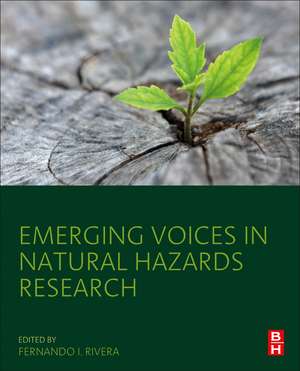Emerging Voices in Natural Hazards Research
Editat de Fernando I. Riveraen Limba Engleză Paperback – 8 iun 2019
Emerging Voices in Natural Hazards Research is intended to serve as a consolidated resource for academics, students, and researchers to learn about the most pressing issues in natural hazard research today.
- Provides a platform for readers to keep up-to-date with the interdisciplinary research that new professionals are producing
- Covers the multidisciplinary perspectives of the hazards and disasters field
- Includes international perspectives from new professionals around the world, including developing countries
Preț: 475.70 lei
Preț vechi: 635.96 lei
-25% Nou
Puncte Express: 714
Preț estimativ în valută:
91.04€ • 98.85$ • 76.47£
91.04€ • 98.85$ • 76.47£
Carte tipărită la comandă
Livrare economică 15-29 aprilie
Preluare comenzi: 021 569.72.76
Specificații
ISBN-13: 9780128158210
ISBN-10: 0128158212
Pagini: 454
Dimensiuni: 191 x 235 x 24 mm
Greutate: 0.78 kg
Editura: ELSEVIER SCIENCE
ISBN-10: 0128158212
Pagini: 454
Dimensiuni: 191 x 235 x 24 mm
Greutate: 0.78 kg
Editura: ELSEVIER SCIENCE
Public țintă
Primary: Academics, faculty, researchers, graduate, undergraduate students, professionals and anyone interested in natural hazards research.Secondary: Emergency managers, policy makers, and local/federal officials. Hazard responders, development experts in the World Bank, UN, USAID officers, and many others. The many academic experts in hazards research in academia, including anthropologists, geographers, geologists, sociologists, public health, and others will be interested.
Cuprins
1. Bug out bags and first aid kits: Undergraduate college students' awareness, perceptions, preparedness, and behavior around severe weather
2. The gender dimensions of the 2013 Southern Alberta floods
3. Morphometric conditions underpinning the spatial and temporal dynamics of landslide hazards on the volcanics of Mt. Elgon, Eastern Uganda
4. Disaster recovery among older adults: Exploring the intersection of vulnerability and resilience
5. Hurricanes, disasters, and food insecurity: The intersection of two social events
6. Homelessness and inequality in the U.S.: Challenges for community disaster resilience
7. Hazardous or vulnerable? Prisoners and emergency planning in the U.S.
8. The recovery process: The standard used to measure Emergency Management effectiveness in the eyes of the public
9. Institutions of higher education
10. Institutionalizing nonprofit influences post-disaster
11. Gender and representative bureaucracy: A qualitative look at opportunities and barriers for women in local emergency management agencies
12. Natural hazards, resilience, and sovereignty: The case of Puerto Rico and the U.S. Virgin Islands
13. People with disabilities: Becoming agents of change in Disaster Risk Reduction
14. Young, mobile, but alone in the cold and dark: Experiences of young urban in-migrants during extreme weather events in the UK
15. Social vulnerability and individual wellbeing: An empirical analysis of first responders in South Korea
16. How do the perceptions of natural hazards influence migration decisions among ethnic minority farmers? Insights from coastal Bangladesh
2. The gender dimensions of the 2013 Southern Alberta floods
3. Morphometric conditions underpinning the spatial and temporal dynamics of landslide hazards on the volcanics of Mt. Elgon, Eastern Uganda
4. Disaster recovery among older adults: Exploring the intersection of vulnerability and resilience
5. Hurricanes, disasters, and food insecurity: The intersection of two social events
6. Homelessness and inequality in the U.S.: Challenges for community disaster resilience
7. Hazardous or vulnerable? Prisoners and emergency planning in the U.S.
8. The recovery process: The standard used to measure Emergency Management effectiveness in the eyes of the public
9. Institutions of higher education
10. Institutionalizing nonprofit influences post-disaster
11. Gender and representative bureaucracy: A qualitative look at opportunities and barriers for women in local emergency management agencies
12. Natural hazards, resilience, and sovereignty: The case of Puerto Rico and the U.S. Virgin Islands
13. People with disabilities: Becoming agents of change in Disaster Risk Reduction
14. Young, mobile, but alone in the cold and dark: Experiences of young urban in-migrants during extreme weather events in the UK
15. Social vulnerability and individual wellbeing: An empirical analysis of first responders in South Korea
16. How do the perceptions of natural hazards influence migration decisions among ethnic minority farmers? Insights from coastal Bangladesh
